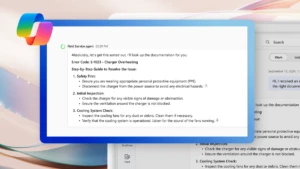
The future of low-code governance with Managed Environments for Power Platform
We are thrilled to announce the general availability of Managed Environments for Microsoft Power Platform, the progressive rollout of the enhancements started today and will continue over the coming weeks to all regions. In July of 2022, we announced the preview of Managed Environments and since then hundreds of customers have enabled Managed Environments with a simple button click to provide IT admins greater visibility and more control of their low-code assets. From automatically delivered weekly digest emails providing insights into how apps are used across the organization to increased control on app sharing in environments, Microsoft Power Platform admins can achieve more with less time and resources spent.
Managed Environments requires all users running apps or flows in that environment to have a standalone Power Apps or Power Automate license, which means if the organization already purchased the appropriate licensing, you can take advantage of Managed Environments today. Before we share some of the great new features that will soon be available in Managed Environments for Microsoft Power Platform, let us discuss the need for an optimized approach of low-code governance.
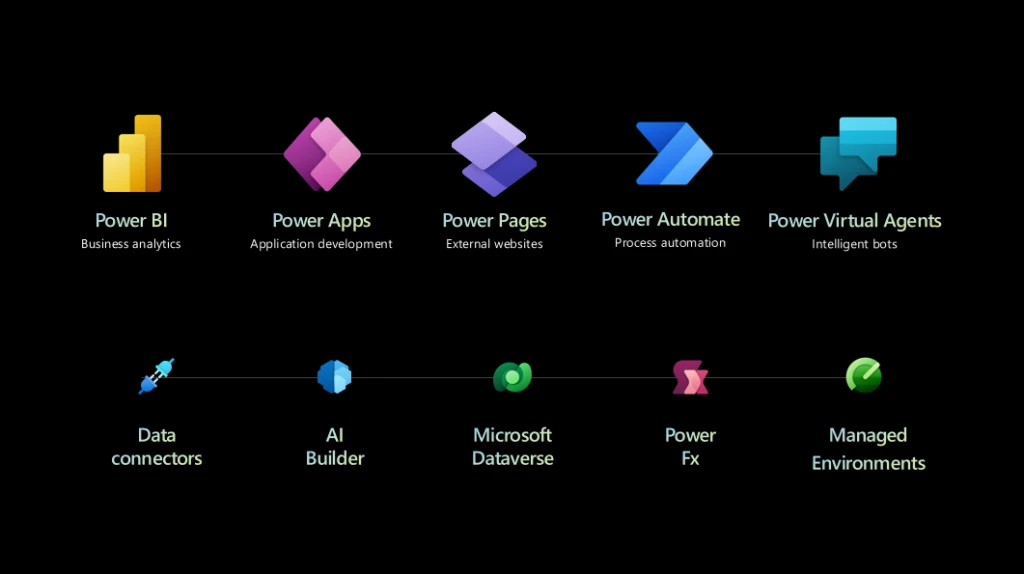
The evolution of low-code governance
While the low-code concept has been around for decades, there has been an evolution in governance capabilities and offerings. In the initial era of low-code development, employees would build solutions in Microsoft Excel, Microsoft Access, Microsoft InfoPath, and other tools, often hidden from their IT departments and all governance strategies or policies.
As technology matured, many of these solutions became cloud-based and were built using a variety of standalone providers. As each provider offered different governance capabilities, organizations needed to face the challenge of overwhelming low-code solution development and the expertise, specialized resources, and additional time to train the admins on the governance tools that must be implemented.
Microsoft Power Platform allows organizations to move to the next era of low-code governance with a central low-code platform that allows makers to enjoy shared components and experiences. Also, for IT admins to manage their low-code assets from a central framework, providing visibility into every asset being created and control to govern at scale.
Tens of thousands of Microsoft Power Platform customers that use the Microsoft Power Platform admin center and the Center of Excellence starter kit to manage their low-code environments can move from reactive to proactive governance with the features offered with Managed Environments for Microsoft Power Platform.
Until now, IT admins would be required to manually install the Center of Excellence starter kit, read through feature documentation, and design and deploy governance workflows that would require updates to grow with the organization. That’s why we introduced Managed Environments to simplify and streamline governance at scale.
Using weekly digest emails, IT admins will no longer have to navigate to the admin center to gain visibility, but the entire experience is automatically configured with a click of a button to be delivered to their inbox, where admins can get a birds-eye-view of their Microsoft Power Platform usage.

App sharing controls allow the admin to limit unnecessary sharing of apps with security groups and set the number of users that an app can be shared within the environment. This can help provide admins with peace of mind as new makers onboard the platform or until apps have been approved for broader sharing. Increased visibility into the data loss prevention (DLP) policies that apply to Managed Environments can furthermore reduce complexity in identifying risks and assessing policy application within an environment. All of these great features are now generally available, and we are excited to also share the future of proactive governance in Microsoft Power Platform with Managed Environments.
Greater visibility at a glance
With Managed Environments, in addition to the weekly digest that is now generally available, IT Admins will soon be able to gather valuable information with insight cards for the admin center homepage. Insight cards will provide information on top makers, apps, and flows. This includes information on the state of apps and flows that may need attention or can be retired if they have not been used in a while to maintain high tenant hygiene.
We are excited to share new licensing reports that will allow Microsoft Power Platform admins visibility into which environments may need license attention and what licenses are being used in Managed Environments. IT admins will be able to ensure that their organization is licensed to use Microsoft Power Platform effectively and efficiently.
Great governance from the start
App sharing controls provide Microsoft Power Platform admins control over who can use apps, and soon solution flows, built within environments to limit the number of users and security groups before apps have been vetted by IT or until users have undergone certain training. With Managed Environments, IT admins can take steps to ensure apps are developed properly from the start with a custom onboarding experience in the product that directs first-time makers to content and guidelines specific to their organization.
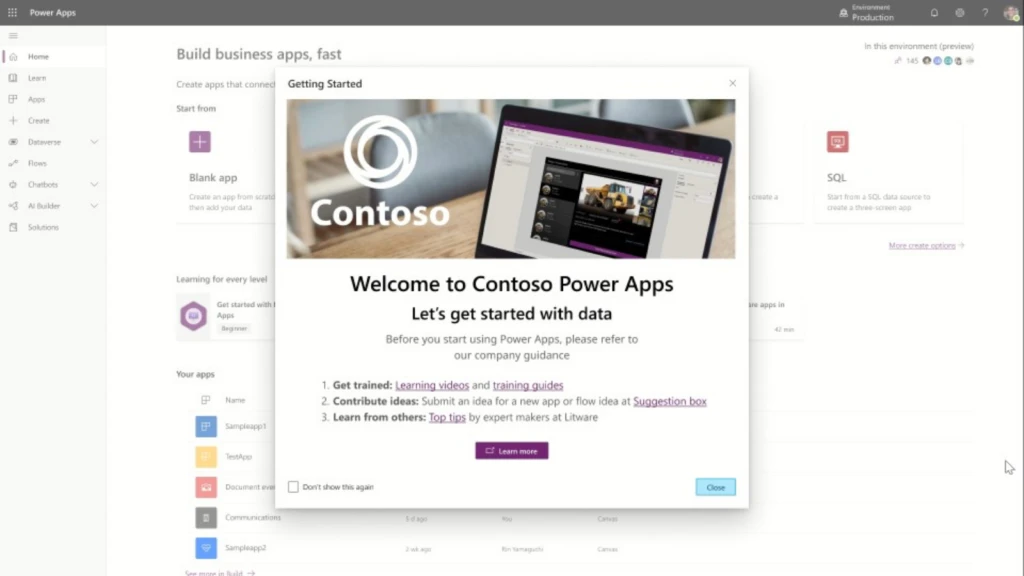
Another great way for IT admins to ensure apps are built properly before being moved to a production environment is to use the solution checker tool which will soon be included in Managed Environments. The solution checker tool can be configured with dozens of security, performance, and reliability rules to alert whenever a violating solution is imported or restrict violating solutions from being imported into a managed environment.
Lifecycle management made easy
One of the more difficult aspects of application governance can be properly implementing application lifecycle management (ALM) in a way that is approachable to everyone. When makers export and import solutions from development environments to production environments manually, IT loses visibility and control over apps. Some customers use pro-dev and IT-centric tools, like Microsoft Azure DevOps and GitHub Actions to implement an automated ALM process in their organization—but these tools are complex and often rely on a DevOps team to drive implementation and oversee the process.
Managed Environments will soon include built-in support for pipelines in Microsoft Power Platform, where ALM automation will be included in-product and the complexity of ALM will be stripped out, providing IT greater governance with less effort. Makers will be able to easily move their solutions from environment to environment using a secure and automated pipeline that is intuitive for the maker while providing greater visibility and a full audit trail to IT. This will allow IT to know when and where apps are being designed and deployed from development to production.
Managed Environments will continue to grow
We are excited for Microsoft Power Platform admins and makers to experience the benefits of proactive governance with all the excellent features of Managed Environments for Microsoft Power Platform. To get started with Managed Environments, simply enable Managed Environments from the Microsoft Power Platform admin center for each environment you wish to include. The team is committed to providing a greater experience for Microsoft Power Platform makers, admins, and developers, and we are thrilled about all the upcoming features and content coming your way.
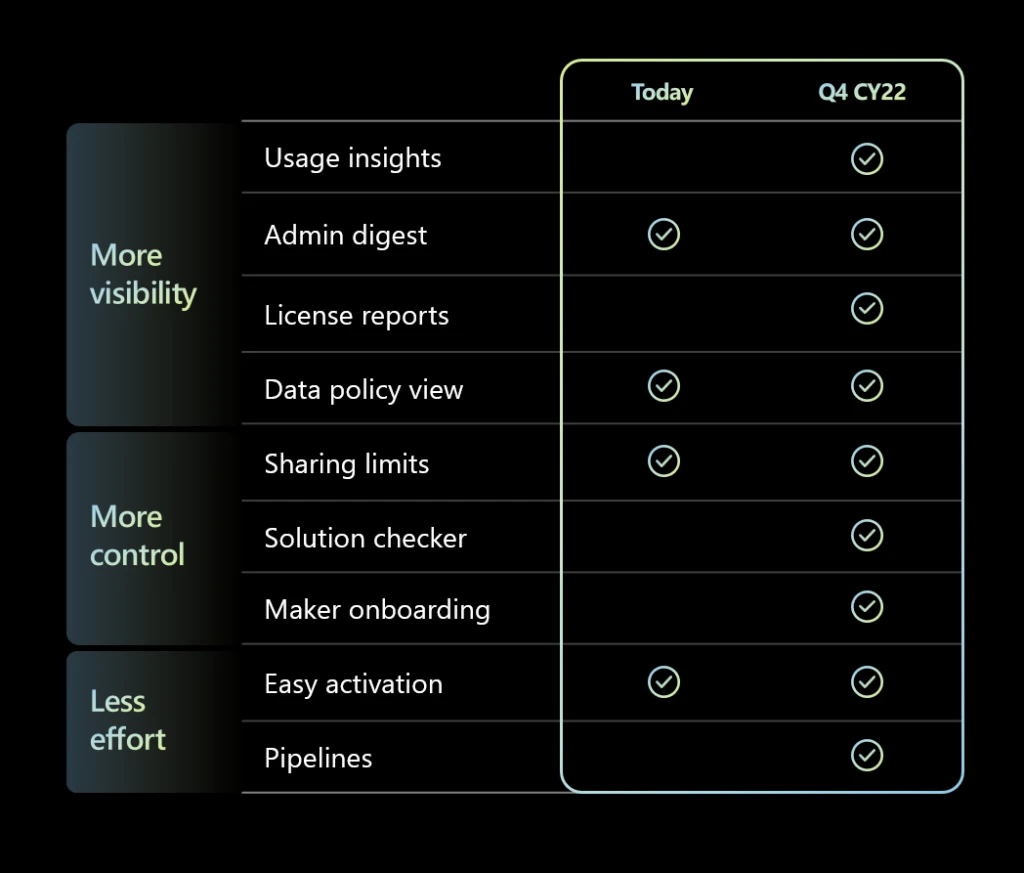
Continued investments across Microsoft Power Platform governance
Governance is a cornerstone of the digital transformation journey that is driven by Microsoft Power Platform, and Managed Environments provides IT admins new capabilities to proactively govern their low-code assets, and is only one way we are continuing to invest and develop a greater governance experience. Recently, we released features for both the Microsoft Power Platform admin center and Center of Excellence starter kit that we would love to highlight as they are integral to low-code governance and adoption strategies.
Tenant-level analytics in Microsoft Power Platform admin center
Microsoft Power Platform admins have been enjoying some of the newer features released such as tenant-level analytics. Admins can see information such as most active makers, the overall number of active apps, app owners, and if those apps have been shared directly within the admin center. Microsoft Power Platform admins are also able to export their data to Azure Data Lake for advanced analytics and a longer retention period of their data.
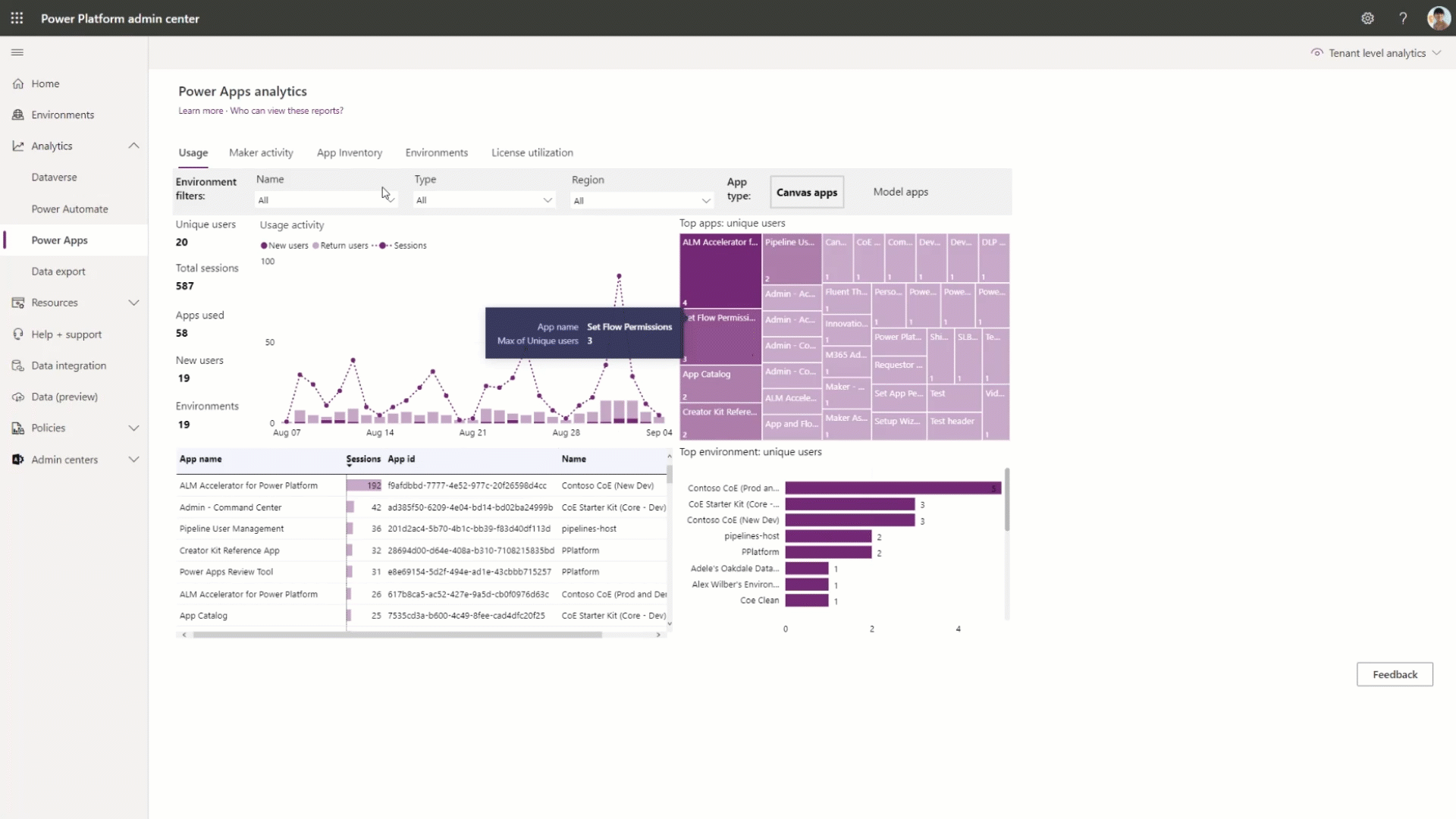
Azure Data Lake connectivity with Center of Excellence starter kit
For customers using the Center of Excellence starter kit, we are excited to announce the new Center of Excellence installation wizard for an easier installation process and the ability to choose to connect directly to Azure Data Lake during the installation process. With longer data retention periods by using Azure Data Lake under your own management and tenant-wide analytics in Microsoft Power Platform, users can enact reactive governance with visibility across the entire tenant.
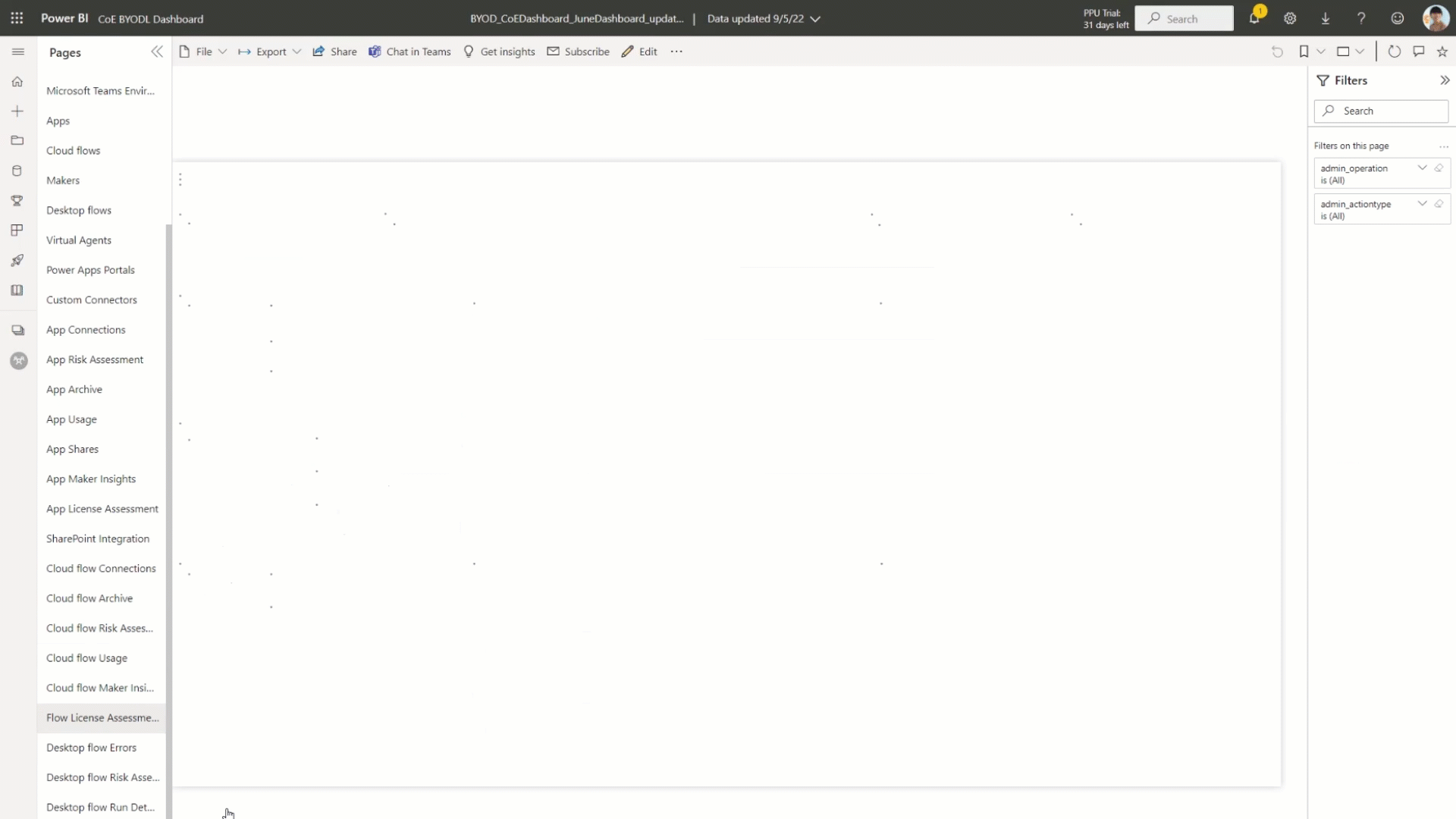
Learn more about Managed Environments
- Managed Environments for Power Platform, Microsoft Docs.
- Governance, Security and Compliance, Microsoft Docs.
- Center of Excellence starter kit.
- Power Platform Adoption site.


